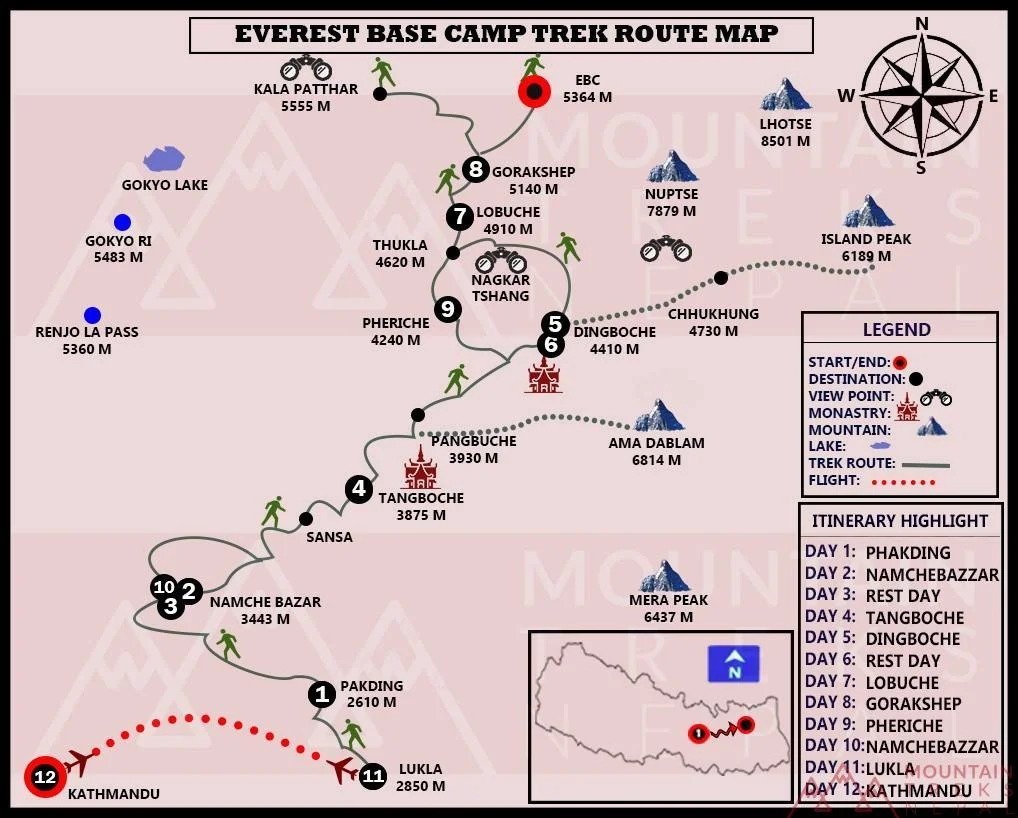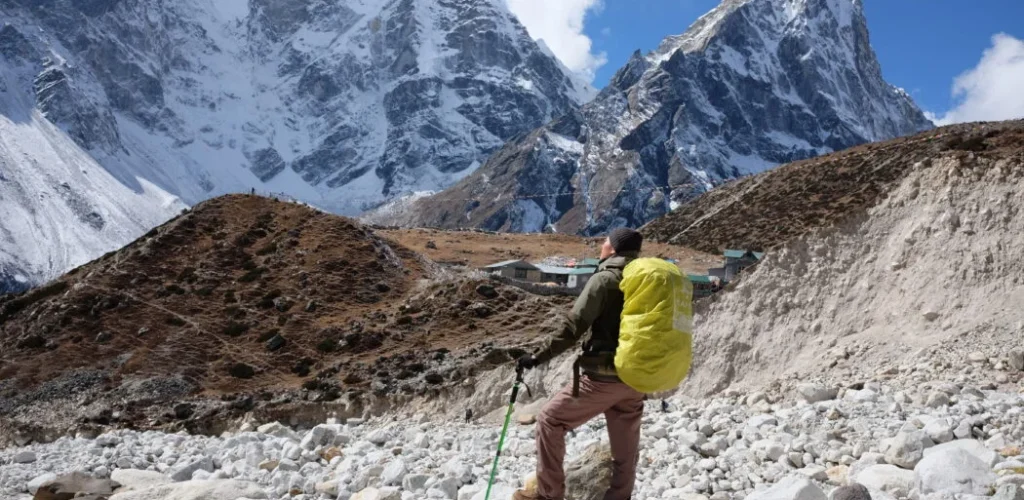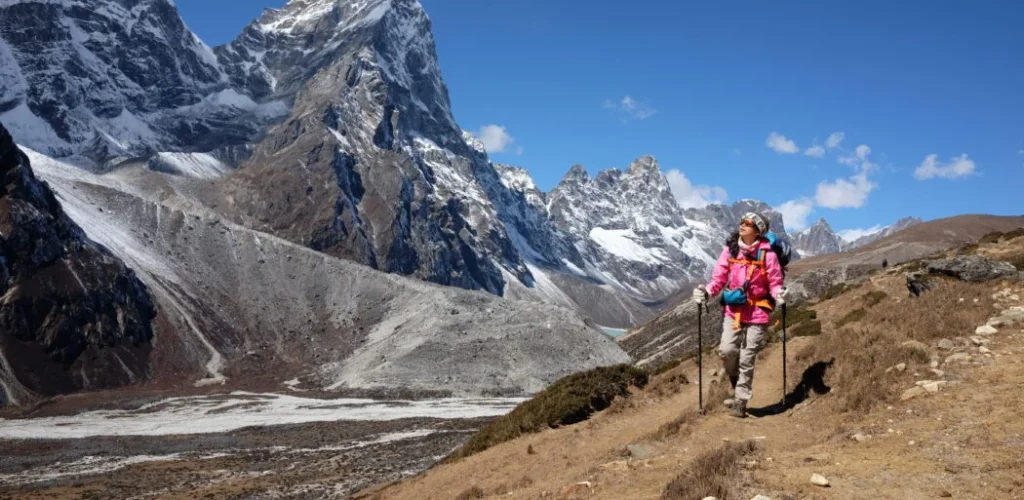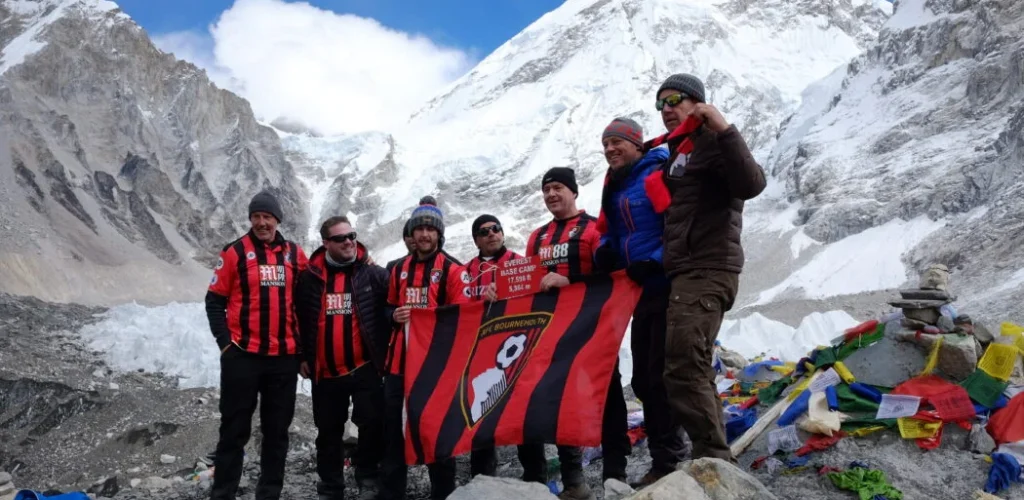Everest Base Camp Trek - 14 Days

-
Duration:
14 days -
Max Altitude:
5545m -
Difficulty Level:
Strenuous -
Group Size:
1- 15 Person -
Destination:
Khumbu / Mt. Everest -
Start/End:
Kathmandu/Kathmandu -
Accommodation:
Hotel/Lodges -
Transportation:
Flight -
Trekking Season:
March to May and September to December
Trip Overview
The Everest Base Camp Trek is one of the world’s premier trekking adventures, with trekkers from all parts of the globe eager to step into the heart of these Himalayas. The trek starts in Kathmandu, Nepal’s capital, where trekkers prepare for expeditions into the Himalayas. One possible option is to travel from Kathmandu to Lukla on a truly breathtaking flight into the small airport, which is the actual commencement of this trek. Winding gradually up through Sherpa villages, lush forests, and along calm rivers, the trail offers magnificent views of the surrounding high mountains, which include the highest of them all, Mount Everest, as well as Ama Dablam, Lhotse, and Nuptse. Along the trail, trekkers learn about the Sherpa culture while discovering many Buddhist monasteries, quaint villages, and traditional farming terraces. The higher one goes, the grander the views of glaciers, icefalls, and the jagged peaks become, effectively aiding in understanding that this is a challenging physical trek, one in which each day demands far more from the trekkers as they get acclimatized to the thin air. Climbing high up to the Everest Base Camp (5,364 m) indeed is a moment never to be forgotten as the trekkers stand beneath the world’s tallest mountain. The trek is not only a journey to Base Camp; it is a journey itself in a beautiful sense of accomplishment, with comradeship, and the otherworldly magnificence of Khumbu turns the whole trek into a lifetime journey.Additional Information
Accommodation and Food
On the Everest Base Camp Trek, the basic form of accommodation is simple teahouses for trekkers. They are also known as lodges and offer a cozy, rustic base where you can relax after a day of walking and feeling cold. These teahouses are basic but comfortable, clean rooms with wooden floors and shared bathrooms. However, as you walk to higher altitudes the facilities become more meagre in nature; they still provide warmth at least after a long day’s trekking. As far as food is concerned, teahouses serve up a selection of local and international dishes. Main meals are usually dal bhat (lentil soup with rice), momos (dumplings) and rice fried in eggs, with western options such as pasta or pancakes. The food is hearty and designed to fuel trekkers, but as you climb there are no longer fresh vegetables so they go on offering basic dishes higher and higher up the trail.Communication and Internet
During the Everest Base Camp Trek, means of communication are very limited. It’s possible to find internet cafes supplying Wi-Fi in small places like Namche Bazar, although the connection rate is often laggy around due to its remoteness. As you progress in altitude, more and more of the available teahouses offer Wi-Fi for a fee. Cellular phone signal is relatively good in settlements such as Namche and Lukla but as you rise higher and higher, the signal becomes weaker. For emergency communication, many trekkers bring satellite phones. If there is an urgent need to get in touch with Kathmandu or the outside world, guides and teahouse owners also have access to these appliances.Guides and Porters
It is highly advised to hire a guide and a porter for the Everest Base Camp Trek. Both safety and a richer experience are assured by their presence. Most professional guides are knowledgeable about the trails, the local culture, and the challenges of trekking at high altitudes. They will provide relevant information about the history and nature of the area and the local customs while also assisting trekkers in acclimatization and health maintenance. A porter takes care of the heavier loads that might otherwise weigh travelers down: mainly gear, equipment, clothing, and personal items so that trekkers may relax and enjoy the trek without worrying about lugging around heavy backpacks. Guides and porters are all well-trained and knowledgeable about the trial and challenges faced. This means hiring the guides and porters creates a stronger local economy and even better trekking experience from the aspects of both safety and smoothness.Conclusion
The Everest Base Camp Trek is definitely a life-altering journey that entails a combination of a physically strenuous trek with some cultural and scenic explorations. From the colorful streets of Kathmandu to the rough terrains of the Khumbu region, every step of the trek brings something new to notice, from the eye-catching views of Everest to the never-ending hospitality of Sherpa folk. This combination of difficult exertion and breathtaking beauty makes the trek rewarding and unforgettable. Whether you are a seasoned trekker or a beginner adventurer, Everest Base Camp Trek provides life memories with a sense of accomplishment that few other treks can equal.Trip Highlights
- Kala Patthar offers breathtaking 360 panoramic vistas (5,555m)
- Khumbu Glacier, the highest glacier(4,900 m)
- Syangboche Airport (3,780m), the world’s highest airport.
- Opportunity to learn about the Sherpa culture and lifestyle.
- A diverse diversity of flora and fauna
- The breathtaking views of the world’s highest summit, 8,848.68 meters.
- Panoramic views of Mt. Lhotse (8,516m), Cho Oyu (8,201m), and Mt. Makalu (8,463m)
- Tengboche’s ancient monastery (3,867mt)
- Exploration of Sagarmatha National Park and see the prayer wheels, colorful flags, Mani stones, and high suspension bridges.
- Wildlife such as musk deer, multicolored pheasants, snow leopards, and Himalayan Thar
Trip Route

Have a Question? Inquire Now
Why Mountain Treks Nepal?
- Expert Team for Unparalleled Experience
- Best Price Guarantee
- Safety is the first Priority
- Easy Booking & Secure Online Payment
- Flexible And Personalized Service
- 24/7 Support
- Highest Satisfaction Guaranteed
- Highly Experienced Guides
- Your Satisfaction is Our Guarantee
- One-time Deposit, Assured for a Life Time
Detailed Itinerary
Your adventure starts when you arrive in Kathmandu, the capital of Nepal — a historic, cultural melting pot of a city with busy streets that reflects modern and traditional lifestyles. The second you exit the Tribhuvan International Airport, the rushed and beautiful ambiance of Kathmandu welcomes you. A representative will take you to your hotel, and on the way, you’ll get your first taste of the city’s distinctive architecture, from ornately carved wooden windows to stately stupas adorned with fluttering prayer flags.
Once checked in and rested, you can explore Thamel, the city’s well-known tourist hub, full of trekking equipment stores, souvenir shops and welcoming cafés offering everything from Nepali dal bhat to global fare. You can also visit Kathmandu Durbar Square, a UNESCO World Heritage sites, devout pagoda-style temples, and even a historic Hanuman Dhoka Palace. This evening, you will meet with your guide for a pre-trek briefing where logistics will be covered before your Himalayan experience begins.
Early in the morning, you will take a spectacular 30-minute flight to Lukla, the gateway to Everest and home of one of the world’s most challenging airstrips. As the small aircraft roars over the Himalayas, you can see the snow covered peaks below are set against a staggeringly varying panorama of deep gorges and rugged landscapes. Landing at Tenzing-Hillary Airport in Lukla (2,800m) is an adventure in itself, since the tiny runway is precariously perched on a mountainside.
After breakfast in Lukla you begin walking and quickly descend through pine forest towards Phakding, following the Dudh Kosi stream and passing houses of butter alike conception and variety.The 3-to-4 hour hike is easy, following the Dudh Kosi River and crossing several swinging bridges decorated with prayer flags. You will pass through Chaurikharka village and reach Phakding (2,610m), a beautiful riverside settlement surrounded by wheat fields and pine trees.The path gives awe-inspiring glimpses of Kusum Kanguru (6,367m), a jade peak with snow on its shoulders.
Today’s trek through the Everest region begins with a gentle hike through the rhododendron and pine forests, crossing thrilling hanging bridges spanning roaring mountain rivers. One famous bridge is the Hillary Bridge, swinging precariously above the Dudh Kosi’s turbulent white waters. Along the way are charming villages like Monjo, where entrance to the stunning biodiversity of Sagarmatha National Park is made official in a UNESCO World Heritage Site.
After permit inspections, the ascent steepens amid dense woodlands, switchback paths twisting skyward between glimpses of distant Everest veiled amid drifting clouds. Approaching Namche Bazaar, the climbers’ first sight of mighty Everest and the neighboring peak of Lhotse gives renewed motivation. Upon arrival in the mountainside town of Namche, called the “Sherpa Capital,” is a buzzing place of teahouses, bakeries and stores selling equipment for the trails as well as woolen garments, the perfect location to rest and adjust to the altitude.
Acclimatization is crucial to prevent altitude sickness and prepare for the higher elevations that lie ahead. Instead of taking a full rest day, trekkers are encouraged to take a short hike to elevations higher than Namche before returning for the night. One option that is quite popular is the hike to the Everest View Hotel located at three thousand eight hundred and eighty meters, one of the highest hotels situated anywhere on Earth, providing a breathtakingly incredible panoramic perspective of Everest, Ama Dablam, and the surrounding peaks that tower all around. Along the way you may visit the Syangboche Airstrip, a minute airfield with a dramatically stunning mountain backdrop.
Those interested in culture can find insight into the traditions, mountaineering history, and lifestyle of the Sherpa people with a visit to the Sherpa Museum. You can also explore Namche’s bustling Saturday market where traders from Tibet and the Khumbu region exchange goods ranging from handcrafted yak cheese to beautifully handmade jewelry. In the evening you can unwind in one of the town’s cozily warm cafés while sipping on a cup of soothing butter tea and taking in the stunning alpine surroundings displayed in all their splendor.
From the bustling streets of Namche Bazaar, today’s trail presents an amazing combination of natural landscapes, inspirational faith and breathtaking mountain vistas at every turn. The trail starts a gentle, winding climb up the mountain-side, which offers stunning views of mountains such as Everest (8,848 m), Nuptse (7,861 m) and Lhotse (8,516 m). As you go through pine forests, watch out for such animals as Himalayan Tahars, musk deer and Nepal’s national bird, the strangely shaped Danphe.After a gradual descent of about two hours to Phunki Thenga (3,250m), a small riverside village, we cross a wooden bridge over the Imja Khola and begin to head on up for two gruelling hours uphill until we reach Tengboche Monastery.
The final leg is a stiff but rewarding climb onwards to Tengboche Monastery (3,860 m), the largest Buddhist monastery in the Khumbu region. It is surrounded by a natural amphitheatre of spectacular peaks, and has become a centre for trekking and climbing in its own right. If you have time, come along for the evening prayers here when the monks chant mantras and remember that sense is where even juniper incense burning adds an aromatic tinge to this sacred atmosphere. View from Tengboche at sunset is unforgettable: the golden sun reflects off snow-streaked summits and throughout the day there are also gentle breezes.
The way from Tengboche to Dingboche is full of beautiful changes of scenery, its richness gradually transforming into the rugged alpine terrain. After winding down a steep slope through rhododendron and juniper forests once again, you cross the Imja Khola and reach Pangboche, a traditional Sherpa village. Here, you can visit Pangboche Monastery, one of the oldest in the area, which is reputed to hold relics-connected with the Yeti legend. The path leads along exposed ridges, soon passing through terraced fields and yak pastures with Ama Dablam ever more dramatically rearing up above us.
You are now gaining height. The landscape becomes steadily more dramatic with towering cliffs and glacial torrents cutting through valleys. After a gradual ascent, you reach Dingboche (4,410m), a delightful settlement clinging to the glacial Imja Valley. Here, unlike the previous villages, the terraced fields are walled in stone as a defense against either wind. From here, Island Peak (6,189m) and the wide valley leading towards Makalu (8,881m) rise before you in all their majesty. The high altitude is apparent as the air becomes thinner and tonight’s halt is essential for your acclimatization.
As you ascend higher, it takes another day of acclimatization to accustom itself to the increased elevation. A favorite acclimatization hike is to the top of Nagarjun Hill (5,100m)—one has to climb steadily until reaching that point but Trekkers are awarded by a view that extends 360 degrees around themselves including towering Himalayan giants such as Makalu, Lhotse (8,516m) and Cho Oyu (8,188m). The climb is tough because there’s less air up here–but it’s an essential step to keeping altitude sickness at bay. If you are lucky with the weather, from the top both Cholatse and Taboche can be seen silhouetted proud in front of the Khumbu Glacier.
Having returned to Dingboche you can then spend the remainder of day with people in Dingboche laughing, chatting, simply happy that they have come once again up here. The scene of the village, herds peacefully grazing yak against the background snow mountains peaks, and clear photographs all offer in their own way plenty of things to take pictures. At night, trekkers often gather together in some teahouses in front of the fireplace, ready with a warm meal. This is a relaxed but needed day of adjusting to high altitude before heading off further toward Everest Base Camp.
Today’s trekking route is very splendid and very tiring from Dingboche to Lobuche. The first part of the day is a steady climb through beautiful alpine meadows with yaks. Rising higher now, the landscape becomes rockier and less fertile, but clear views of the glacial valley below make up for everything. You pass through Thukla (4,620m), where trekkers and climbers often rest up briefly before tackling the tough climb ahead.
Immediately beyond Thukla is the famous Thukla Pass, an emotional site covered with memorials dedicated to those who died on Everest. These stone cairns draped with prayer flags stand quietly as a silent thank you to mountaineers for their courage and sacrifice. From the top of the pass the track continues along the moraine of the Khumbu glacier, offering beautiful views in all directions of Pumori (7,161m), Lingtren (6,749m) and Nuptse.
It is among the most eagerly awaited moments to reach the base of Mount Everest. The trail runs along the lateral moraine of the Khumbu Glacier, rocky and ragged as you start your hike from Lobuche. The higher altitude makes each step more strenuous, but seeing Everest draw near raises spirits for the most part. After hours Gorak Shep (5,164m), last inhabited place before base camp, arrives. You take a short break here and continue pending the last push to base camp.
The route to Everest Base Camp is really challenging, with broken rock and slippery ice even though the pinnacle stands at the historic site-5,364m. The infamous Khumbu Icefall looms around you as well the world’s giant mountain below- Everest. Trekkers can take photographs and congratulate themselves on their success, then absorb the strange spirit all around them. After a while at base camp, they step back through the same broken shale to Gorak Shep and rest for tonight, tired but contented with hard-won success.
The tenth day of the Everest Base Camp Trek starts early. After overcoming one heart-pounding but fulfilling barrier after another, you finally arrive at Kala Patthar (5545m), well-distinguished as its famous viewpoint offering some of the best panoramas over Everest to be had anywhere. As the first rays of sunlight strike the snow-capped peaks, Everest, Lhotse and Nuptse are bathed in a golden hue. The scene is unreal and unforgettable. The ascent is steep and tough going, especially with the thin air giving you a much tougher time of it.
After soaking in the majestic views of magnificent Kala Patthar, you start your hike down-relatively easy but still challenging. You will pass through areas of glacial moraine and finally come to Pheriche (4240m), a peaceful village tucked onto the mountainside In the Imja Valley. Pheriche is calmer than places like the Khumbu lodge-and it presents, a good chance for trekkers to slow down from the fast pace of life at Everest Base Camp and take stock of their journey.
Your journey down to Namche Bazaar today will be a relief after the heavy hiking upwards of the previous days. The trail winds through alpine meadows as you go up and down along the Imja Khola, with magnificent views of Ama Dablam in the distance. You will pass through several smaller villages including Pangboche where you can visit Pangboche Monastery and then continue down river through prime rhododendron forest filled with birdsong and the noise of torrents. The spectacle remains stunning and as you descend, oxygen levels increase making breathing easier. With several hours’ trekking, you will find yourself returning to Namche Bazaar where it is good to recall your journey.
Coming back to Namche is returning to the beginning after one goes out for a few days of trekking in Khumbu region again. Once more the town springs to life with its bustling cafes and busy market stalls offering fresh vegetables on a Saturday morning like nowhere else can do. This is a great opportunity to relax, enjoy a hot cup of soup and reacquaint yourself with fellow trekkers before carrying out the final stage of your trip back to Lukla.
This is the final day of trekking where you return to Lukla. This is a familiar path and, after days of strenuous climbing, it feels good to be descending. As you go through the towns of Jorsalle and Phakding, some parts will indeed look familiar: you’re backtracking some of today’s steps from Day 2. Underneath this ever-changing environment, though, the scene always stays beautiful. Mountain rivers such as the Dudh Kosi continue to rush past you on the way down. As you go through lusciously green forests and open spaces with terraced fields of crops, their tumultuous waters course beside yours right into your heart. Before long, the contrast between rugged mountain scenery and lower gentler slopes becomes more and more marked.
Lukla’s small, buzzing atmosphere brings a feeling of nostalgia for the trek now ending. Once you’ve checked into your teahouse on arrival, there’s time to put your feet up and relax. It’s a good moment at night for one last look back over your extraordinary journey, before taking the return flight to Kathmandu. Many trekkers like to have a congratulatory dinner with their guide and fellow trekkers, as they talk about the challenges and what they’ve had to conquer on their Everest adventure.
After an early morning meal in Lukla, you take a small plane back to Kathmandu. The 30-minute flight offers a thrilling experience, as once again you fly above the Himalayas, getting one final bird’s-eye view of valleys, alpine settlements and towering peaks that lie below or lay in now faded outline at least till just past this morning sunrise. When you arrive in Kathmandu, you’ll be transferred to your hotel. You can relax, take a hot shower and enjoy some well-earned rest after that epic journey up and down the world’s highest mountain.
The rest of today is free for you to explore – whether you spend your day visiting such cultural gems as Swayambhunath Stupa (Monkey Temple) or Patan Durbar Square, or you shop around for souvenirs in Thamel, there’s plenty around to keep your thoughts off the punishing endurance test known as trekking. This is your opportunity to enjoy Kathmandu’s cultural richness one more time before setting out on its roads again.
It’s the final day of the Everest Base Camp trek. You will be preparing for departure from Kathmandu, Nepal. Depending on your flight schedule, you might still have quite a bit of time to go shopping or see any places which have remained unvisited until now. Or just maybe, you’ll just want to rest up at the hotel and have a break there before leaving again the following morning. Our representative will escort you to Tribhuvan International Airport from where you will board a flight to your home country.
Trip Includes
- 14 days Trip, 11 of which include 3 meals a day.
- 2 nights of accommodation in Kathmandu, breakfast included.
- Round-trip airfare between Kathmandu and Lukla.
- Lodge accommodation during the trek.
- Airport transfers (Domestic and international).
- Everest trekking permit and TIMS (traveler security) Card.
- An experienced English-speaking Trek leader (Trekking guide), assistant leader( 8trekkers:1 assistant guide ) and porters to curry luggage (2trekkers:1 porter) including their salary ,insurance , equipment , all transportations , food and accommodation.
- Porter service form lukla.
- Local and government taxes.
- Insurance for porter and guide.
- Sleeping bag, down jackets and duffel bag – if Necessary (Need to returned after the trek).
- Farewell Dinner with Nepali culture show.
Trip Excludes
- Personal Travel insurance.
- International airfare.
- Nepal entry visa.
- Drinks (mineral water, Tea, coffee, whisky) or other snacks and any meals beside breakfast, lunch and dinner. Hot shower, battery. changes, Wi-Fi charge etc.
- Tips for Guide and porter( Tipping is Expected).
- personal expenses.
- Personal trekking equipment.
- Any others expenses which are not mentioned on the “Trip Includes” Section.
Departures Costs and Dates
Packing List For Everest Base Camp Trek

General
- Four-season (zero degree) sleeping bag
- Sleeping bag liner
- Puffy down jacket
- Daypack (35-45 liters) with rain cover
Upper Body
- Warm Hat
- Sunglasses
- Scarf/Neck Gaiter/Buff (highly recommended)
Torso
- Moisture-wicking base layers
- Insulating layers (fleece jacket)
- Puffy down jacket
- Waterproof and windproof outer shell jacket
Frequently Asked Questions

The best time to go on the Everest Base Camp Trek is during the Spring and Autumn seasons. You can expect favorable weather conditions and clear surroundings during these timeframes.
It takes 14 days to complete the whole Everest Base Camp Trek.
The highest altitude you reach during this trek is Kala Patthar at 5644 meters above sea level.
Yes, since Everest Base Camp Trek takes you over 5500 meters above sea level, altitude sickness is a real concern. So you must acclimatize and rest before hiking to higher altitudes.




Leave a Review